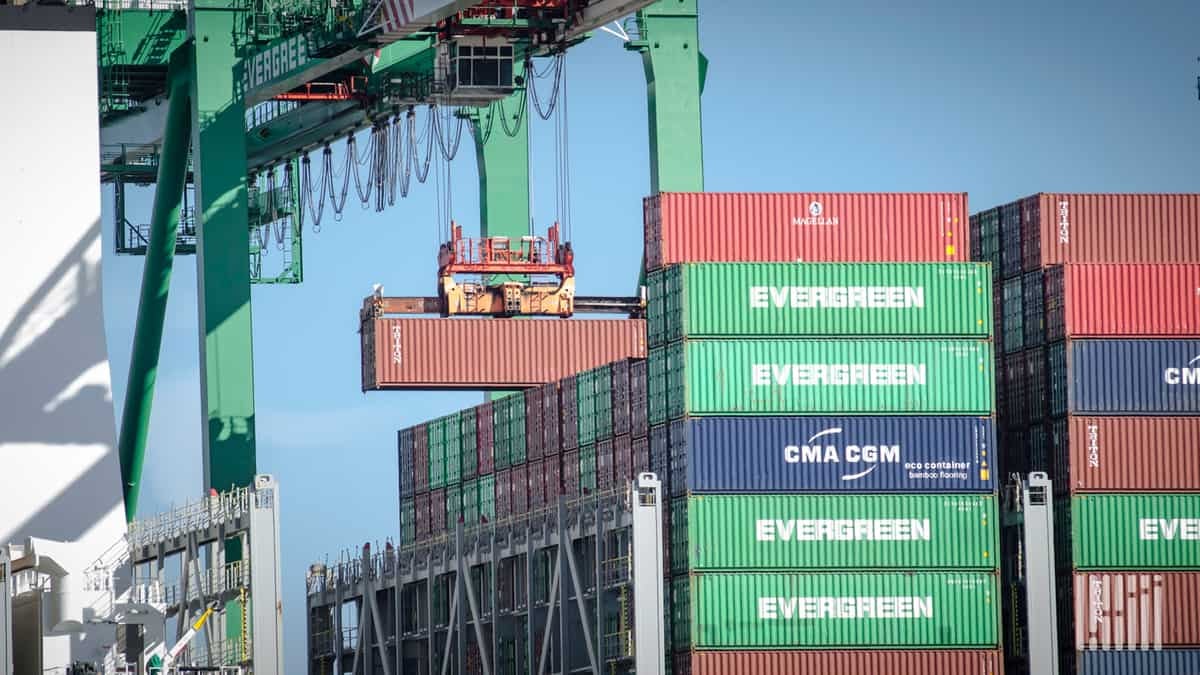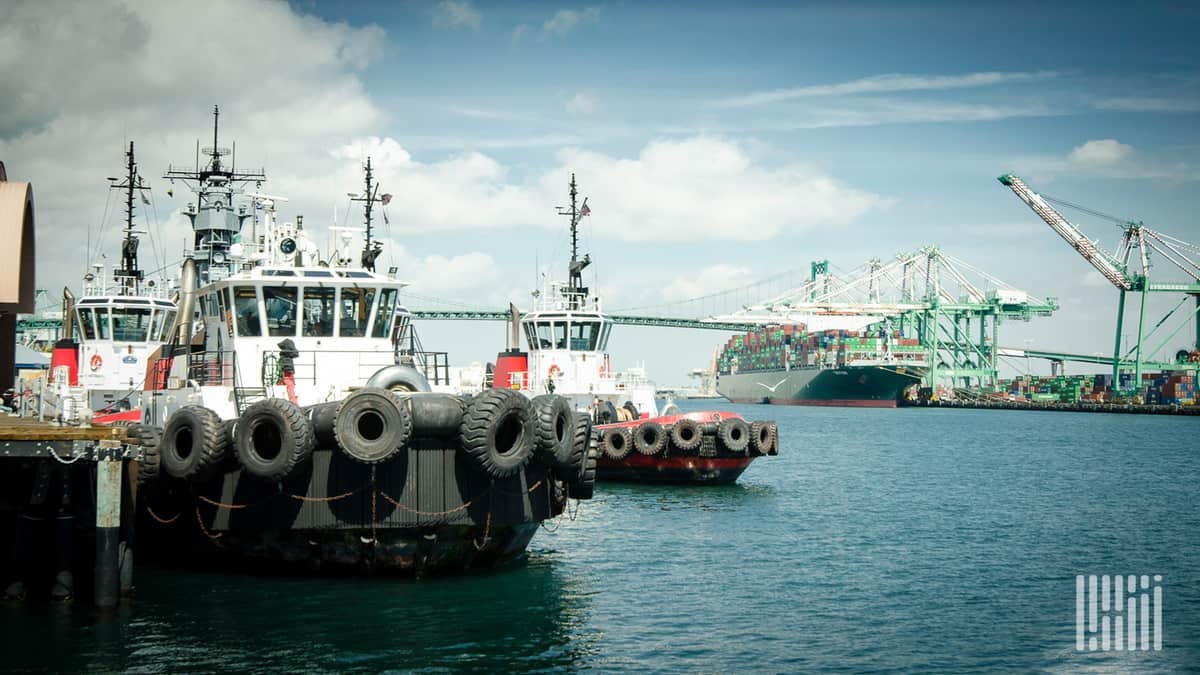It has been a year of record rates and extreme service disruptions for ocean container shipping. The astounding scale of U.S. consumer demand has exceeded all expectations, pushing supply chains to the brink — in some cases, beyond the brink.
How long will supercharged container demand endure? How will ocean carriers react when volumes finally pull back? How much will U.S. importers pay for ocean transport in 2021? Will they be able to afford it?
To answer these questions and more, FreightWaves interviewed Nerijus Poskus, head of global ocean freight at Flexport, the San Francisco-based digital freight forwarder. The following is an edited version of the conversion:
January may be ‘worst month ever’
FreightWaves: There’s no visible letup in U.S. containerized imports in December; 2020 is in the books. Then we have Chinese New Year starting Feb. 12 and shippers always bring cargo forward in January to prepare for that. Do you see January volumes stronger than December’s, and post-Chinese New Year as the first real chance for a volume decline?
Poskus: “Unfortunately, I do. I think the current demand will continue until at least the end of Q1 2021, a bit after Chinese New Year. And it looks like January may be one of the strongest months ever because you have all this demand coupled with a lack of [container] equipment.
“When I say strongest, I don’t mean just volumes. I mean there will be more demand than importers and freight forwarders and carriers can handle. January may be the worst month ever for shipping.

“You have to be prepared to pay elevated rates. The Shanghai index [Shanghai Containerized Freight Index (SCFI)] plus a premium, in some cases a large premium. You don’t want to pay the cheapest price on the boat because if you do, your goods are not going to move.
“When you see $3,800 [per FEU on the SCFI], that’s not moving freight today on the trans-Pacific eastbound. in many cases you have to pay $5,000 or $6,000 [including a premium] just to get space on vessels. Otherwise you have to wait three or four weeks. Until the issues with container availability are resolved, you really want to pay the elevated rate. I don’t see that importers have any other option.”
Box surge demand drivers
Where is all this containerized import demand coming from? Is it still Christmas? Are these goods that people are buying for use around their homes? Is this business inventory restocking?
“We’re definitely still seeing Christmas gifts coming in but we are not seeing any more new bookings for Christmas gifts. Everything is already on the water or struggling to leave origin and stuck somewhere in China. Some of these goods will not make it here in time for Christmas.
“[In terms of non-Christmas shipments] we’re seeing bikes, furniture, all kinds of fast-moving consumer goods. Inventories are still extremely low. That doesn’t mean there are no inventories in the U.S. It just means that you may no longer have a choice. If you want to buy something, sometimes you can only choose what’s in stock.”
Threat to annual contract pricing
If you believe high import demand will last at least through Q1, what do you think will cause it to pull back after that?
“Until the vaccines are widely distributed and things start reopening and people start spending money on services, they will keep spending money on goods. People are tired of sitting at home, and buying something is a way to make themselves a little bit happier. And the services they used to spend money on were quite expensive. It wasn’t just haircuts. It was things like travel. That’s a significant amount of money [being redirected from services to goods].”
But if you look at the timing, this raises a big question for shippers. If you’re talking end of Q1, that extends higher spot rates right into the trans-Pacific annual-contract renewal period. We’re already in the contracting period for the Asia-Europe container lane now. Does this imply that 2021 annual contract rates will be higher for U.S. shippers?

“Indeed, the timing brings it to when you renegotiate your contract rates. I’m very confident that the record-high spot prices will affect the fixed prices in 2021 across the board. No more $1,400 [per FEU] to the West Coast or $1,200 on Asia-Europe.
“Asia-Europe contracts are being negotiated right now, but we still have a little bit more time to see what happens in the market until the annual trans-Pacific contracting negotiations. I think how successful or unsuccessful the European importers are in renegotiating new contracts will affect the prices for the trans-Pacific importers.
“I don’t know how high those [trans-Pacific] contract prices are going to be. But for sure, they are going to be higher. Regardless of what happens with demand.”
Balance of power to carriers
Why regardless of demand? Even if for some reason — such as the surge in COVID cases and unemployment — demand suddenly drops off?
“No matter what happens with demand, the carriers have learned how to manage capacity a lot better this year [via the practice of “blanked,” or canceled, sailings]. Capacity management is here to stay. If the prices are not high enough, the carriers will just start reducing capacity. So, I think prices will remain elevated.
“I would not say the current spot price in the market of around $4,000 per FEU plus a premium of $1,500-$2,000 [to guarantee space] is sustainable. I do not believe 2021 will be more expensive for importers paying spot prices. But when it comes to a fixed market price of $1,400 from Shanghai to Los Angeles — I think those times are gone. The contract prices are going up. Not just for 2021. I think it is a structural change until supply and demand balance again. If that ever happens.
“The big headline here is that supply and demand has shifted in the carriers’ favor. Carriers are now so good at managing capacity proactively that they have an edge in the market. And that edge is there to stay, probably for quite a few years.
“Between 2012 and the beginning of 2020, the market was driven by demand. The demand side was deciding what it would pay the carriers, to the point where the carriers would almost go bankrupt. I think that is over. The carriers will decide what the right price is, the price they want to get.”
Upper limit to transport costs
There are limits to container freight rates though. For example, in the crude-tanker industry, rates can only go so high. If there is a major geopolitical event, very large crude carrier (VLCC) spot rates may spike to $200,000-$300,000 a day. But if that persists, refiners stop booking cargo because the transport cost wipes out their margins. Won’t the same thing happen to U.S. goods importers if the transport cost is too high?

“I have had this discussion with importers of very expensive furniture and they mentioned exactly the same thing. They said that if prices go up any higher than they are today, they will have to stop importing because they would no longer make their margins. I think there are quite a few commodity groups that will not be able to pay higher prices, which you would think at some point would balance supply and demand.
“But at this point that’s still not happening. On reason is that if it affects only a few importers [in a category], they have to compete with their competitors. If you’re not going to shut down, you don’t have an option [but to continue importing]. So, it could be that behind the scenes, some companies are operating at a loss due to their very expensive transportation rates just to stay afloat.”
The rise of premium ocean
For those who are in a position to pay a higher price and still get an acceptable margin, one of the more attractive options these days is ocean premium service. These container services provide guaranteed loading, faster ocean transits and priority discharge. Earlier this year, when air cargo capacity was slashed by COVID cuts to passenger flights, shippers switched from air to premium ocean. You predicted these services would become more important when we spoke back in March and that is exactly what has happened since then. Do you see this trend accelerating even further?
“I do. When Zim launched its premium service [eCommerce Express, in June], it was immediately full. I think there are more premium services needed. There are issues with air freight beyond Shanghai and Hong Kong. There are issues in places like Taiwan and Vietnam, so premium services are very much needed in these other areas.
“I also see a future where premium services call at smaller ports in the U.S. Los Angeles is very congested. The first few carriers doing premium ocean, like CMA CGM and Zim, were able to get terminals that were less congested and have been able to perform these premium services. But at some point, it won’t be an option [to offer expedited discharge at larger congested ports].”
There’s also yet another variable in the very near future regarding air cargo. Not only is the passenger-plane belly capacity still highly constrained, but we’ve got vaccines coming. This should push even more air cargo into premium ocean containers.
“Vaccines will be a huge market for air freight. As vaccines move by air freight, a lot of cargo from air will be shifted to premium ocean and that will last for quite a while. At least through the first half of 2021. Probably longer.”
The future: enforceable contracts?
If you add up everything we’ve just talked about, it sounds to me like 2021 will be a very good year for container carriers and a very expensive year for shippers. It also sounds like next year will see continued complications in terms of equipment availability, scheduling and reliability. Looking forward, is this just the way it is? Or is there a way that the business relationship between shippers and container carriers can improve?
“I think we as an industry need more performance-based contracts that are digitally enforceable both ways [for each party]. We need more than just handshake agreements that are on paper but not enforceable, where if the price goes up you may no longer get the space and if the price goes down importers all the sudden don’t ship enough cargo [with the agreed carrier] because they’re shipping with somebody else.
“If there’s no equipment, the carrier needs to pay a penalty and if you agree to ship 100 TEUs and you ship 50, you need to pay a penalty. It doesn’t matter who provides these contracts, whether it’s a company like NYSHEX or the carriers themselves. But I think this is the only way out of this situation.
“Today, everything’s a discussion. Everybody’s unhappy. Everybody’s blaming each other. It’s just not where it should be. And I have a sense it’s going to change fast.” Click for more FreightWaves/American Shipper articles by Greg Miller
MORE ON CONTAINERS: The mystery of the frozen trans-Pacific spot rates: see story here. COVID lockdown sequel threatens container shipping demand: see story here. Containers are the ‘new gold’ amid ‘black swan’ box squeeze: see story here.







